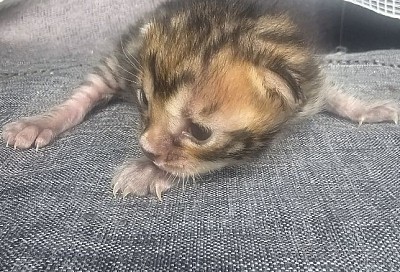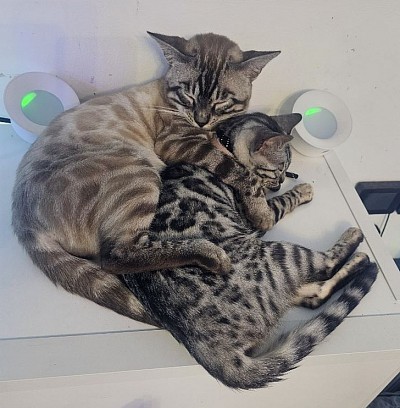Care Guidelines for Your Queen and Her Kittens
Care Guidelines for Your Queen and Her Kittens
Care for Your Queen Postpartum
Following the birth of your cat’s litter, it is imperative to closely monitor the mother and her kittens to ensure their well-being and healthy development. A robust beginning is vital for the kittens to mature into strong, healthy cats. While your cat will naturally care for her offspring, limiting interference and allowing her to embrace her maternal role is advisable.
Care Guidelines for Your Queen and Her Kittens
Please adhere to the following essential steps after your cat has given birth:
- Maintain a Warm Environment: Ensure the room housing your cat and her kittens is kept warm.
- Keep Bedding Clean: Regularly inspect and refresh their bedding to maintain dryness and comfort.
- Provide a Quiet Space: Minimise noise and disturbances to protect the mother and her kittens; restrict access to family members as needed.
- Monitor Nursing: Observe the kittens to confirm they are nursing adequately, while maintaining a respectful distance to avoid stressing the mother.
- Separate from Other Pets: Prevent other household pets from approaching the mother and her kittens.
- Assist Feeding if Required: Kittens should begin nursing shortly after birth; if they have not started within 30 minutes, gently guide them to their mother.
Should you have any concerns regarding their care, please consult your veterinarian promptly.
When to Contact Your Veterinarian
Although most feline births proceed without complications, certain issues warrant immediate veterinary attention. Contact your vet if you observe any of the following:
- Vaginal bleeding or abnormal discharge.
- Uterine prolapse (protrusion of the womb).
- Mastitis is characterised by swollen, painful, and warm mammary glands.
- Loss of appetite, excessive thirst, or vomiting.
- Uncoordinated movements, twitching, or collapse.
Typical Maternal Behaviours Post-Birth
Many cats instinctively exhibit maternal behaviours such as:
- Grooming: Licking and nuzzling her newborns accompanied by purring.
- Relocating Kittens: If the environment feels unsafe or too cold, she may move her kittens to a new location. It is important not to interfere; instead, provide a warm, quiet, and comfortable space.
- Protectiveness: The mother may display heightened protectiveness and altered behaviour towards humans. Respect her boundaries until she becomes more at ease.
While minor behavioural changes are normal and typically resolve within weeks, veterinary consultation is advised if you notice:
- Severe distress or pain potentially leading to harm towards her kittens. Maintaining a calm and familiar environment can reduce stress.
- Rejection or neglect of any kitten; applying birthing fluids to the kitten may encourage maternal acceptance.
Nutritional Requirements for Your Cat Postpartum
During lactation, your cat requires enhanced nutrition to support both herself and her kittens. A diet rich in calories, fats, and proteins that is easily digestible is essential. Providing high-quality kitten food during this period ensures adequate nutrient intake for optimal growth and facilitates the weaning process.
Handling Newborn Kittens
It is advisable to avoid handling newborn kittens initially, as the mother may be highly protective. Respect her space until you are confident that all is well. After approximately two weeks, if the mother appears comfortable, gentle handling and socialisation may commence.
Neutering Your Cat Post-Lactation
Neutering your female cat is a responsible measure to prevent unwanted pregnancies and certain health complications. This procedure is typically recommended about eight weeks after birth, once the kittens are fully weaned, allowing the mother adequate recovery time. Consult your veterinarian for personalised guidance. Note that cats can be neutered from four months of age to prevent early litters.
When Can Your Cat Resume Outdoor Activities?
Given that kittens require feeding every two to three hours, your cat will likely remain close to them during the first week postpartum. As the kittens mature and gain independence, the mother will gradually resume outdoor activities.
Comprehensive Guide to Kitten Development
Newborn kittens rely entirely on their mother for nourishment, warmth, and comfort during their initial weeks. If you have rescued an orphaned kitten, it is crucial to acquire pertinent information regarding their sleeping and feeding needs to support them through this vulnerable period. Although caring for a kitten may seem challenging, it becomes manageable with experience. Untamed provides essential insights on:
- Developmental milestones during the first eight weeks of life
- Your cat’s nutritional, sleeping, and elimination requirements
- Early detection of illness and allergies
- Customised cat food tailored to your kitten’s specific needs
Week-by-Week Kitten Growth Overview
Kitten care demands full-time attention. Determining their age, often by weight, is a crucial first step to provide appropriate care and nutrition.
Refer to the table below for an age-appropriate weight chart to estimate your kitten’s age:
Kitten Age | Weight (grams)
Newborn | 50–150
Week 1 | 150–250
Week 2 | 250–350
Week 3 | 350–450
Week 4 | 450–550
Week 5 | 550–650
Week 6 | 650–750
Week 7 | 750–850
Week 8 | 850–1,000
This chart serves as a general guideline; variations may occur based on breed, sex, lifestyle, and health. If you suspect your kitten is over- or underweight, assess additional developmental and behavioural indicators for accuracy.
First Week Developmental Highlights
Newborn kittens have closed eyes and folded ears, relying primarily on their sense of smell. They exhibit bright pink gums and paws, are unable to stand, and depend exclusively on their mother’s milk or kitten milk replacement formula for nutrition and warmth.
During the first week, kittens sleep 20 to 22 hours daily, facilitating:
- Organ development
- Bone strengthening
- Muscle growth
Developmental milestones during the first week include:
Age | Developmental Changes
Day 1 | Closed eyes, folded ears, inability to stand, attached umbilical cord
Day 3 | Closed eyes, partially unfolded ears, emerging senses of smell and taste
Day 6 | Slight movements, partially open eyes, umbilical cord detachment
Day 7 | Open eyes, gradually unfolding ears, environmental awareness
If mother’s milk is unavailable, administer kitten milk replacement (KMR), which mimics feline milk composition. Feed slowly to prevent choking or vomiting, as newborns lack a gag reflex.
Maintain ambient temperature between 35–36°C to ensure warmth. Stimulate elimination by gently rubbing the kitten’s abdomen with a baby wipe until defecation occurs.
Developmental Expectations at Two Weeks
At two weeks, kittens remain close to their mother or caregiver for warmth and security. Key developmental and behavioural milestones include:
- Eyes gradually open fully, though vision remains limited; initial blue eye colour will transition to the adult shade by approximately two months.
- The ear canals fully open; the ears are small and rounded.
- Exploration begins with uncoordinated movements.
- Birth weight should have doubled.
- Increased interaction with siblings and caregivers.
- Heightened sensory development; kittens may hiss at unfamiliar stimuli.
Three-Week-Old Kitten Development
By three weeks, sex differentiation is possible: females exhibit a straight genital slit, males a circular opening. Teething commences with the eruption of incisors. Ears become erect, and claws begin retracting. Activity levels increase with improved motor skills, including walking and standing. Kittens consume more milk and begin to defecate independently, marking an ideal time to initiate litter training.
Four-Week-Old Kitten Milestones
At four weeks, kittens transition out of the neonatal phase, exhibiting confident walking, environmental awareness, and playfulness. Developmental changes include:
- Fully extended ears and the ability to sit upright.
- Emergence of canine teeth.
- Transition from milk to solid food begins; introduction of wet food is recommended.
Post-First Month Growth
By one month, kittens display increased energy, engaging in play and social interaction. Their senses are well-developed, enabling running, chasing toys, and sibling interaction. They sleep wherever they become tired.
Five-Week-Old Kitten Development
Socialisation and exploration are prominent at this stage. Milestones include:
- Fully retractable claws.
- Emergence of premolars.
- Increased independence.
By five weeks, kittens’ digestive systems are typically mature enough to consume exclusively wet kitten food. Ensure ample water availability to prevent dehydration, indigestion, and constipation.
Six-Week-Old Kitten Development
Molars begin to appear, signalling the nearing completion of teething. Hearing and vision are fully developed, fostering curiosity. Kittens should be capable of stable jumping and landing. The FVRCP vaccination is recommended around this age to protect against rhinotracheitis, calicivirus, and panleukopenia.
Seven-Week-Old Kitten Milestones
At seven weeks, kittens typically eat four to five times daily and are fully weaned. Semi-moist or dry kitten food may be introduced as treats; however, dry food should not constitute the sole diet due to its lack of moisture, which can lead to dehydration, urinary tract infections, and kidney issues. Excessive consumption of dry food, which is calorie-dense, may contribute to obesity and related health problems. Eye colour begins to shift to the adult hue, and energy levels increase with a slight reduction in sleep. Training and introduction of scratching posts and interactive toys are advisable.
Eight-Week-Old Kitten Expectations
At eight weeks, kittens weigh approximately 850 to 1,000 grams and should consume wet food regularly. Deworming and veterinary checks for internal parasites are recommended. If more than 14 days have elapsed since the initial FVRCP vaccine, a booster is advised.
Sterilisation should be considered from four months of age to prevent:
- Unplanned pregnancies
- Spontaneous catfights
- Undesirable hormonal behaviours
Optimal Nutrition for Developmental Success
Proper feline nutrition is critical for healthy growth. Inadequate feeding can result in diarrhoea, vomiting, and food poisoning, leading to dehydration and severe weight loss, which jeopardises development.
Appropriate Diet for Your Kitten
Upon introduction of solid foods, provide diets free from grains, sugars, fruits, vegetables, and other carbohydrate-rich ingredients. Cats are obligate carnivores; their digestive systems are optimised for meat and fish, not carbohydrates.
Avoid artificial colourants and flavour enhancers, which may cause digestive disturbances and allergic reactions.
Feline diets should be rich in animal proteins, containing less than 20% animal fat. Animal proteins supply essential amino acids such as arginine and taurine, crucial for healthy development. Plant-based proteins provide empty calories and may hinder growth.
Foods to Avoid for Kittens
Certain human foods are toxic to cats. Exercise caution to prevent poisoning, allergies, and malnutrition. The following table outlines problematic ingredients:
Difficult-to-Digest Ingredients | Toxic Foods
Vegetables such as carrots and potatoes | Onions and garlic
Grains including corn | Chocolate
Grass | Citrus fruits such as oranges
Apples and strawberries | Raisins and grapes
Caffeinated products and beverages | Raw egg (risk of bacterial infection)
Causes and Prevention of Kitten Mortality
Kittens may succumb to a variety of causes, some unavoidable such as congenital defects, while others can be prevented through responsible breeding and diligent care. Common factors include fading kitten syndrome, infections, inadequate nutrition, unsuitable environmental conditions, and complications arising from inbreeding. Responsible breeders endeavour to reduce losses by maintaining strict hygiene, providing optimal nutrition, and closely monitoring the kittens. Nevertheless, despite best efforts, some kitten fatalities remain statistically inevitable.
Common Causes of Kitten Mortality
Fading Kitten Syndrome: This term describes kittens that are born healthy but subsequently weaken, cease nursing, and die, predominantly within the first two weeks of life.
Infections: Kittens are vulnerable to various infections that can prove fatal.
Low Birth Weight: Underweight kittens tend to be weaker and have a lower survival rate.
Congenital Abnormalities: Some kittens are born with significant physical defects.
Inappropriate Environment: Exposure to extreme temperatures, poor sanitation, and overcrowding can elevate mortality rates.
Poor Nutrition: Insufficient or improper nutrition of the mother cat (queen) can adversely affect milk quality, thereby impacting kitten health.
Inbreeding: Pedigree cats may experience higher mortality rates due to inbreeding, which can compromise immune function or cause genetic disorders.
Dystocia: Birth complications, such as inadequate uterine contractions, can result in stillbirths or neonatal death.
Practices of Responsible Breeders
Providing an Appropriate Environment: Ensuring the birthing area is warm, well-ventilated, and sanitary.
Ensuring Proper Nutrition: Feeding the queen a diet that supports optimal milk production and offspring health.
Close Monitoring of Kittens: Observing for signs of distress including failure to nurse, lethargy, or weight loss.
Maintaining Hygiene: Keeping the environment clean to reduce infection risk.
Managing Inbreeding: Conducting genetic testing and avoiding breeding closely related cats to minimise inherited disease risks.
When to Be Concerned
High Mortality Rates: Elevated kitten deaths may indicate genetic health problems, inadequate care, or disease outbreaks.
Unscrupulous Breeders: Some breeders prioritise profit over animal welfare, resulting in unhealthy or dying kittens.
If you have concerns regarding the welfare of kittens from a breeder, please contact a local animal welfare organisation for assistance.



